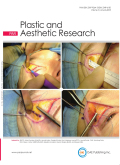- 钛学术文献服务平台 \
- 学术期刊 \
- 医药卫生期刊 \
- 外科学期刊 \
- 整形与美容研究(英文版)期刊 \
Soft tissue coverage of cranial defects: an update
Soft tissue coverage of cranial defects: an update
基本信息来源于合作网站,原文需代理用户跳转至来源网站获取
摘要:
Scalp and cranial defects can occur as a result of cutaneous or bony malignancies, trauma, or surgical intervention for intracranial tumors. Soft tissue cranial reconstruction of composite defects presents a unique challenge given the relative tissue inelasticity of the scalp, need for tension free closure, and convex shape of the cranium. An added complexity is found in patients with large defects, cerebrospinal fluid leak, prior failed reconstruction, infection, or previous radiation. Methods and materials for skull reconstruction have evolved significantly over the years, allowing surgeons to repair even the most challenging composite defects with excellent success rates. This review aims to discuss and evaluate the available soft tissue options for cranioplasty coverage, with particular focus on hostile reconstructive fields and the use of free tissue transfer.

推荐文章
一种基于A-means聚类算法的Sweep Coverage机制
无线传感器网络
覆盖机制
扫描覆盖
移动控制
聚类
K-均值
基于Soft多结构元素形态学的TM图像边缘检测
数学形态学
图像模型
多结构元素
边缘检测
Soft多结构元素
基于soft-soil轮胎的自行火炮动态响应仿真研究
轮式自行火炮
松软土壤
轮胎模型
车辙
动态响应
Rapid and sensitive method for determining free amino acids in plant tissue by high-performance liqu
HPLC
OPA
FMOC
Free amino acids
Plant
PLS-DA
内容分析
关键词云
关键词热度
相关文献总数
(/次)
(/年)
文献信息
| 篇名 | Soft tissue coverage of cranial defects: an update | ||
| 来源期刊 | 整形与美容研究(英文版) | 学科 | |
| 关键词 | |||
| 年,卷(期) | 2021,(5) | 所属期刊栏目 | Review |
| 研究方向 | 页码范围 | 10-20 | |
| 页数 | 11页 | 分类号 | |
| 字数 | 语种 | 英文 | |
| DOI | 10.20517/2347-9264.2021.21 | ||
五维指标
引文网络
引文网络
二级参考文献 (0)
共引文献 (0)
参考文献 (0)
节点文献
引证文献 (0)
同被引文献 (0)
二级引证文献 (0)
2021(0)
- 参考文献(0)
- 二级参考文献(0)
- 引证文献(0)
- 二级引证文献(0)
引文网络交叉学科
相关学者/机构
期刊影响力
整形与美容研究(英文版)
主办单位:
出版周期:
月刊
ISSN:
2347-9264
CN:
开本:
出版地:
陕西省西安市高新区绿地SOHO B座1705室
邮发代号:
创刊时间:
语种:
eng
出版文献量(篇)
440
总下载数(次)
0
总被引数(次)
32
期刊文献
相关文献
推荐文献
- 期刊分类
- 期刊(年)
- 期刊(期)
- 期刊推荐
整形与美容研究(英文版)2022
整形与美容研究(英文版)2021
整形与美容研究(英文版)2020
整形与美容研究(英文版)2019
整形与美容研究(英文版)2018
整形与美容研究(英文版)2017
整形与美容研究(英文版)2016
整形与美容研究(英文版)2015
整形与美容研究(英文版)2014
整形与美容研究(英文版)2021年第9期
整形与美容研究(英文版)2021年第8期
整形与美容研究(英文版)2021年第7期
整形与美容研究(英文版)2021年第6期
整形与美容研究(英文版)2021年第5期
整形与美容研究(英文版)2021年第4期
整形与美容研究(英文版)2021年第3期
整形与美容研究(英文版)2021年第2期
整形与美容研究(英文版)2021年第12期
整形与美容研究(英文版)2021年第11期
整形与美容研究(英文版)2021年第10期
整形与美容研究(英文版)2021年第1期

 免费查重
免费查重










